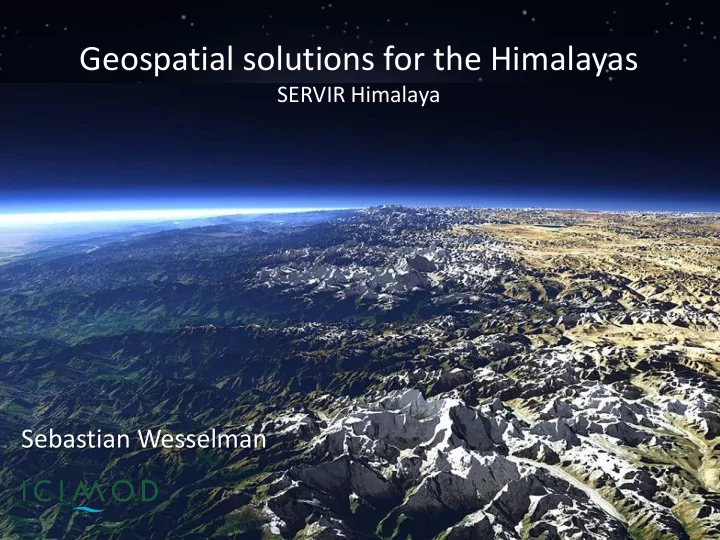

Geospatial solutions for the Himalayas SERVIR Himalaya Sebastian Wesselman
• The International Centre for Integrated Mountain Development (ICIMOD) is working in Afghanistan, Bangladesh, Bhutan, China, India, Myanmar, Nepal and Pakistan • Aim: Address challenges related to globalization and climate change that affect mountain ecosystems and livelihoods
The Hindu Kush-Himalayan Region Sources of freshwater reserves - headwaters for 10 major river systems An area of majestic beauty – a world heritage site for Climate biodiversity Change Great relevance of Earth Demographic Observation due to inaccessible Change conditions and lack of data Land use Increase adaptive capacity and Change resilience of mountain and downstream communities Globalization Social Change
USAID-NASA SERVIR Initiative SERVIR Facility at NASA SERVIR-Himalaya SERVIR-Mesoamerica SERVIR-Africa SERVIR ~ to serve To improve environmental management and resilience to climate change by strengthening capacity of governments and key stakeholders to integrate EO and geospatial technologies into decision making for sustainable development
Framework for Science Applications and Information Systems Priority Stakeholder National Questionnaire Gap Issues/ Areas survey Consultations Workshops Analysis Priorities Data and Information EO GIS In-situ Knowledge Data and Integration Data Data Data Base Information Framework Analysis and Qualitative Quantitative Spatial Tools and Thematic Modeling Modeling Modeling Analysis Methods Applications Visualization and web- Interactive (Near) Real-time SERVIR-Himalaya Decision based Mapping Information Platform Support Platform Institutional Strengthening Data Access and Capacity Building and Plan / Policy & Pilot Applications and Sharing Training Decision making networking
Earth Observation for sustainable mountain development Aligning with GEOSS Priority Areas
Cryosphere & Water
Cryosphere & Water Glacier mapping Automated snow cover product Hydrological modeling Product Product use design & verification application National partners Ancillary Tools data adoption Snow Melt Runoff Basin level water Models management
Cryosphere & Water Historic changes of Snow and Glaciers in the HKH • Glaciers Monitoring - decadal change 1980-2010 • Snow cover dynamics
Monitoring changes in glaciers and glacier lakes Tibet Himalaya Bhutan Himalaya Image is a portion of an uncalibrated ASTER Level 1A VNIR false-color image (321RGB), acquired on November 20, 2001
Cryosphere & Water
Cryosphere & Water • Hydrological modeling - Climate change and water availability scenarios (Wanchu basin, Bhutan)
MODIS based automated snow cover monitoring
Ecosystems & Biodiversity
Ecosystems & Biodiversity • Land cover change and GHGs • Multi scale biomass modeling • Phobjika habitat conservation Product Product use design & verification application National Partners Field data Tools support adoption Forest cover RAMSAR site REDD MRV reporting monitoring framework systems system
Forest Land cover Nepal 2010 1990 2000 2010 Remote sensing based approaches for Operational forest REDD+ mechanism in community monitoring system forestry of Nepal Multi resolution satellite data based biomass models for baseline carbon Green house gas inventory (Forest carbon flux) assessment and monitoring
Pragati , Janapragati and NibuwaterCommunity Forest
Pragati , Janapragati and NibuwaterCommunity Forest
Tree Crown Size Analysis 2002 Tree Crown Size 2002 <50 150-200 50-100 200-250 100-150 >250 2009 Tree Crown Size 2009 <50 200-250 50-100 250-300 100-150 300-350 150-200 >350
Multi-scale Biomass Modeling REDD MRV Framework Landsat TM based Spatial • To develop multi resolution satellite data based Biomass map (Decision tree model) biomass models for baseline carbon assessment R 2 =0.7674 and monitoring • Spatial biomass models tested, under calibration • Landsat TM Seasonal Multispectral Reflectance • GeoEye based Stand level canopy Morphology Parameter Variable Importance • GeoEye based Species level canopy projected area • MRV Spatial frame work being worked out
Disasters & Natural Hazards
Disasters & Natural Hazards Forest fire detection & monitoring Flood early warning system Product Product use design & verification application National Partners Ancillary Tools data adoption Near real time Flood early fire reporting warning system system
Earth Observation: Forest fire detection SMS alert
Agriculture & Food Security
Agriculture & Food Security In season crop monitoring Crop production assessment Product Product use design & verification application National Partners Historical Tools data adoption Agriculture Crop Planning Drought management Warning system
Crop Growth Monitoring and Production Assessment Crop production assessment in peak of season In season crop growth monitoring In season anomaly maps based on 10 years Establishing relation between crop production average vegetation conditions data within the and Season Max. NDVI based on 10 years data agriculture areas of Nepal for wheat crop
Air & Atmosphere
Air & Atmosphere Automated Aerosol Monitoring Validation of MODIS Aerosol Data Air Quality and Health Product Product use design & verification application National Partners Ancillary Tools data adoption Satellite based air quality reporting system
MODIS based applications
Visibility and partnerships
Access to Information
Outreach and Capacity Building • Symposium • Workshops/Training • Youth Forum • Science Applications Showcase
Youth Programme
Way forward • Raise awareness and make use of the wealth of Earth Observation data • Regional collaboration, exchange of data and standardizing methodologies • Capacity building • Work with key partners to implement geospatial solutions
Thank You...
Recommend
More recommend